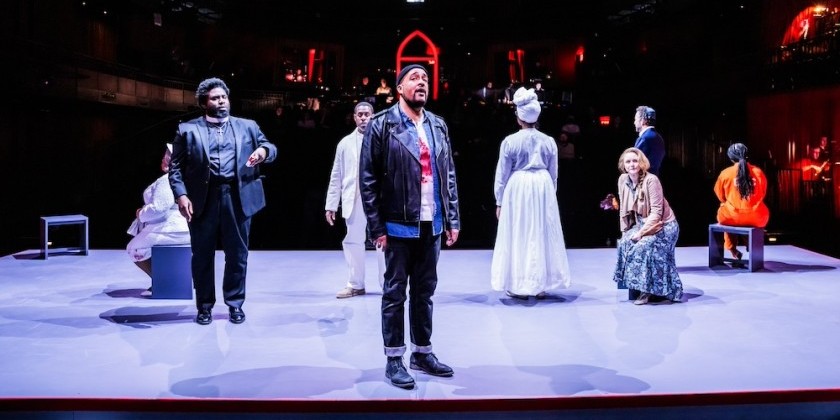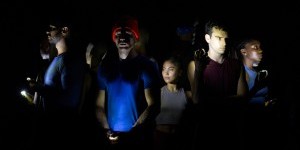IMPRESSIONS: Bill T. Jones, Marc Bamuthi Joseph and Tamar-kali's "Watch Night" at the Perelman Performing Arts Center

Co-Conceiver, Director and Choreographer: Bill T. Jones
Co-Conceiver and Librettist: Marc Bamuthi Joseph
Composer: Tamar-kali
See remaining artist credits at end of article.
Self-styled as “an opera and a poetry reading hav[ing] a bar fight in a church about American rage and race,” Watch Night is a disorienting, disjointed theatrical experience of all these elements and more. Staged deep within the forbidding concrete confines of the monolithically imposing Perelman Performing Arts Center, the work (like the building itself) evidences years of creative planning and investment, though ultimately it alienates more than it welcomes.

Watch Night falls most comfortably in the multidisciplinary genre and tonal register of musical theater, though the aesthetics of its component parts tread variously, if at times unevenly, through a broad range of references. Its subject matter centers around the 2015 mass shooting in the Emanuel African Methodist Episcopal Church in Charleston, South Carolina in an attempt to reckon with historical violence, race-based hatred and rage, and their unconscionable result: “why bullets fly where people pray.” The production’s loose narrative traces the reverberant aftermath of the shooting and a parallel “copycat” shooting at the Tree of Life synagogue in Pittsburgh to highlight the tensions between vengeance and forgiveness in the face of violence.

Artistically, the production overflows with star power and articulates a deep collaboration between its three creative leads: director and choreographer Bill T. Jones, poet and librettist Marc Bamuthi Joseph, and composer Tamar-kali. The cast is likewise brimming with talent, and though they at times hang together rather tenuously, Danyel Fulton, Josette Elaine Newsam, and Ṣọla Fadiran stand out for their vocal power and dramatic nuance. Movement and song are mutually supportive in the immersive staging, with dance interludes that emerge with functional and narrative purpose as scene changes or shadows of characters’ history and conscience. The chorus and dance ensemble is appropriately billed through its function as “Echo Chamber,” a morphing entity that constantly shifts their stance and role, made visible through changes in costume and body language. An ensemble of eight string and woodwind musicians bring the minimalist, atmospheric score to life with sustained tension and precise timing, though throughout the music functions more as a sonic backdrop and less as a character in itself. Joseph’s poetry is the driving force of the work’s message, insistently studded with repetition and chilling wordplay that questions as powerfully as it cuts. LED boards around the high perimeter of the performance space display words and images that correspond to the stage action, alternately supporting and distracting from the cast’s performative power.

The work takes a critical stance not only in its vivid portrayal of the assailant—here named only as “the Wolf”—but also in its nuanced depictions of the surrounding community and the media. It is this last, portrayed through the internal motivations of an investigative journalist, that resonates most quizzically: urged on by the prospect of fame and money in a story “ready-made for Hollywood,” these sinister motivations call into question sensationalized media portrayals of racial violence—a question that bears a reflexive examination within Watch Night itself. In a social and political climate that too often capitalizes on the commercial viability of tragedy, when does the theatricalized retelling of violence constitute a necessary action with salient aims, and when does it simply perpetuate harm? Who is the intended audience for this message, and what are we expected to walk away from Watch Night having learned or been spurred to change in our world?

In African American culture, “watch night” is a traditional New Year’s religious celebration that commemorates slavery and freedom through faith-based acts of worship, song, and dance. Its tone is as reflective as it is forward-looking, anticipatory, and hopeful—a testament to resistance and resilience grounded in community. Watch Night reappropriates this tradition in markedly somber and furious tones, alluding to the darkness and hypervigilance that arise from individual and collective trauma. Mired in confusion and rage, Watch Night seems to have no future, no hope, no light in mind. Just as the production itself asks, I ask of it: “why?”
Ken Alston Jr. - Super/Natural // Amanda Bailey - Echo Chamber; Shayla/Ms. Laura u/s
Royer Bockus – Echo Chamber; Ms. Summers u/s // DeJa-Simone Crumpton - Echo Chamber u/s
Kevin Csolak – The Wolf // Ṣọla Fadiran – Winters // Danyel Fulton – Shayla // Brian Golub – Rabine
Chelsea Nicole Green - Echo Chamber // Raquel Jennings – Super/Natural u/s
Damon McToy - Josh/Saul u/s // Brandon Michael Nase - Josh // Josette Elaine Newsam - Ms. Laura
Ariel Neydavoud - Echo Chamber; Rabine u/s // Onyie Nwachukwu - Super/Natural
Jill Paice – Ms. Summers // Oneika Phillips - Echo Chamber // Devin L. Roberts - Echo Chamber
Arri Lawton Simon – Saul // Jonathan McClinton Smith - Echo Chamber // Cooper Stanton - Echo Chamber u/s; Wolf u/s // Miguel Ángel Vásquez - Echo Chamber; Winters u/s
Chelsea Starbuck Smith – Violin 1 // Justus Ross – Violin 2 // Will Curry – Viola // Terrence Thornhill – Cello
Corey Schutzer – Bass // Mira Magrill – Flute// Hsuan-Fong Chen – Oboe // Yu-Ting Cheng – Clarinet
Adam Rigg – Scenic Designer // Kara Harmon – Costume Designer // Robert Wierzel – Lighting Designer
Mikaal Sulaiman – Sound Designer // Lucy Mackinnon – Projections Designer //
Anika Seitu – Hair, Wigs and Makeup Designer // Lauren Whitehead – Dramaturg // Adam Rothenberg – Music Director
Tamar-kali – Orchestrator // David Lai – Music Coordinator // Jason Paul Tate – Fight Director















